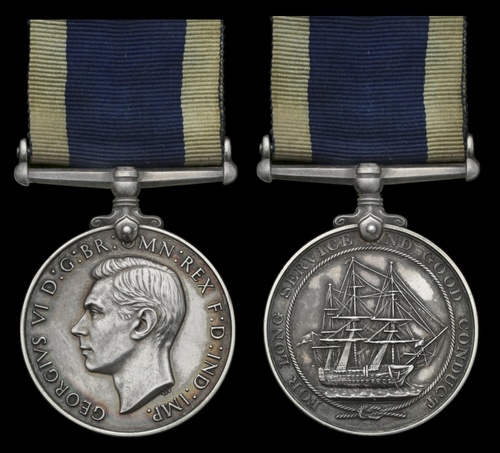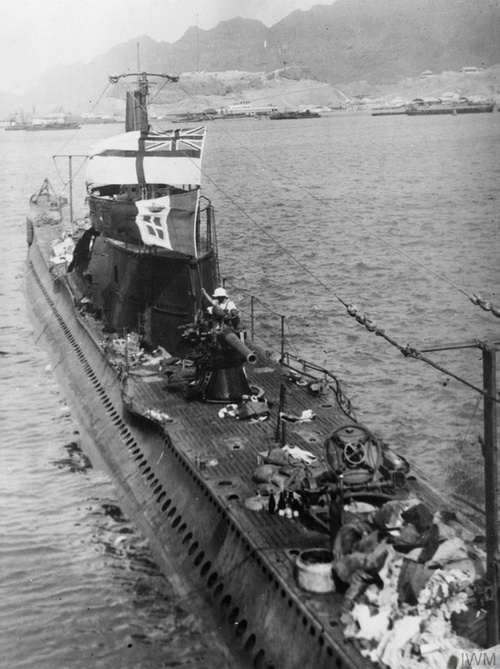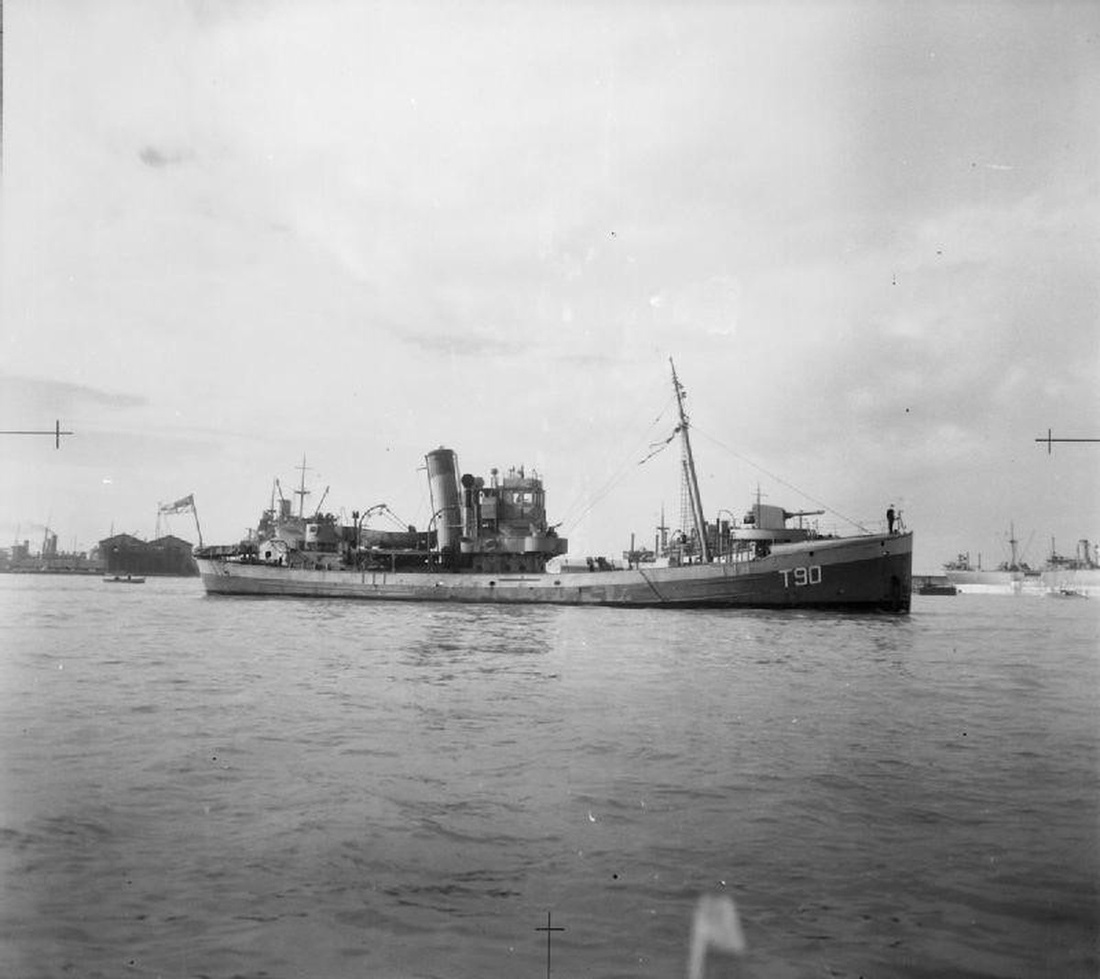Auction: 22003 - Orders, Decorations and Medals
Lot: 383
19 JANUARY 1940: FIRST CAPTURE OF AN ENEMY SUBMARINE
'Just before noon [on 19 January 1940], Moonstone's ASDIC operator reported a strong submarine echo and the trawler immediately steamed to the attack, dropping depth charges; but again, the enemy escaped. Then, barely an hour later, the trawler regained contact and dropped more depth charges. The explosions had scarcely subsided before the submarine, a big ocean going boat, suddenly heaved itself to the surface a mile astern, streaming the Italian flag from a pole above its conning tower.
Moonstone wheeled hard round and steamed full ahead with all guns fixing, some of the crew even joining in with rifles as the distance between the two vessels narrowed. Though the submarine, which was fully three times the size of Moonstone, quickly returned fire, the hail of lead and shell from the trawler prevented the Italians from getting to their big gun, and finally, Moonstone's four inch gun crashed a shell into the conning tower, killing all inside it. Some of the Italians began to wave white clothes in surrender, while others scrambled into the wrecked tower to haul down the flag.
There were far too many Italians for the trawler's small crew to handle, so after warning the enemy commander not to scuttle or she would reopen fire, Moonstone stood off while Kandahar raced in to take the prisoners aboard and fix a tow to the big submarine, the Galileo Galilei … Kandahar then towed Moonstone's prize to Aden, where it was warmly received as it was the RN's first enemy submarine captured in the War.'
Harry Tate's Navy: Trawlers Go to War, by Paul Lund, refers.
The Royal Naval L.S. & G.C. Medal awarded to Chief Stoker W. E. Roberts, Royal Navy, who was present in H.M. Trawler Moonstone on the occasion of her spectacular action against the Italian submarine Galileo Galilei on 19 January 1940
Royal Navy L.S. & G.C., G.VI.R, 1st issue (K. 63764 W. E. Roberts, S.P.O., H.M.S. Vindictive), good very fine
William Edgar Roberts was born in Oswestry, Denbighshire on 2 July 1905 and entered the Royal Navy as a Stoker 2nd Class in April 1924.
Advanced to Stoker Petty Officer in November 1939, he was awarded his L.S. & G.C. Medal in March 1939 and was serving in H.M. Trawler Moonstone on the outbreak of hostilities.
The ex-Hull trawler was initially assigned to the 4th Anti-Submarine Patrol Group at Alexandria but subsequently transferred to the Red Sea, in which capacity she achieved a notable wartime 'first', namely the capture of the Italian submarine Galileo Galilei in the Gulf of Aden on 19 January 1941. Three days earlier, she had rescued the crew of the Norwegian tanker James Stove, a victim of the Italian submarine, but the latter would shortly fall to Moonstone's gunnery, for she was spotted by our aircraft. Of events the following day, the 'WW2 Talk' website takes up the story:
'At 1137, H.M.S. Moonstone obtained a contact at 5,000 yards and 14 minutes later attacked with one charge set to 150 ft., the depth of water being 37 fathoms. A full pattern could not be dropped because the ship's speed against the sea and swell was insufficient. Owing to the long range at which contact was obtained the U-Boat probably heard Moonstone and dived deep. The trawler regained contact at 300 yards and at 1220 attacked with one charge set to 150 ft., speed again not being sufficient for a full pattern. Six minutes later another charge was dropped and four minutes after this the U-Boat broke surface 2,000 yards astern. Moonstone turned as quickly as possible whilst the U-Boat opened fire; keeping bows on to the enemy the trawler returned such a fierce Lewis gun fire that the Italian crew, after some erratic shooting, were driven from their guns. When the range closed to 500 yards, all spare hands in the Moonstone, armed with rifles, assisted the Lewis gunners, and the enemy's decks were subjected to a deadly fusillade.
A direct 4-in. hit on the base of the conning tower, followed by another at the top, finished the action. The whole enemy crew rushed on deck, hauled down the colours and frantically waved white clothing. Moonstone ceased fire at 1255.
H.M.S. Kandahar arrived and, after sending a prize crew on board, endeavoured to tow the U-Boat; the tow parted very soon, but the prize crew eventually got the engines running and Galileo Galilei entered Aden Harbour under her own power, flying the White Ensign.'
The Italian submarine had suffered losses of 12 killed and four wounded; Moonstone had no casualties. For his gallantry Moonstone's skipper, Bosun William Moorman, was awarded the D.S.C. and recommended for an officer's commission. Petty Officer Frederick Quested, in charge of the gun crew, received the D.S.M.
As related by the historian Stephen Roskill,
'The prize was a very valuable one and from her we obtained intelligence regarding the disposition of other Italian submarines in the Red Sea and Indian ocean. As a result, we caught and sank the [Brin-class submarine] Torricelli on 23rd June and the Galvani, which was patrolling the Persian Gulf to catch our tanker traffic, on the following day… '
Subsequent career
Departing the Moonstone in February 1941, Roberts joined the sloop Falmouth in the same month, and remained likewise employed until May 1942.
Between August 1942 and January 1945, he served in the repair ship Wayland, in which period he was advanced to Chief Stoker, and between January and April 1945 he served at the naval base Haitan on Addu Atoll in the Indian Ocean.
He was finally released to the reserve from the Fleet Air Arm base Nightjar in April 1946.
Subject to 20% VAT on Buyer’s Premium. For more information please view Terms and Conditions for Buyers.
Sold for
£320
Starting price
£130









